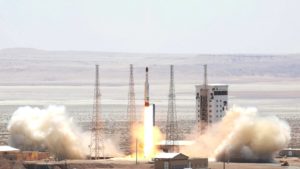
Iran launched its Simorgh space launch vehicle (SLV) into space on Thursday, July 27, 2017, from the Imam Khomeini Space Centre.
The Simorgh SLV (Farsi for ‘Phoenix’) was not thought to have carried a payload. The U.S. Air Force’s Joint Space Operations Centre (JSpOC) at Vandenberg Air Force Base in California reported that it had not detected any satellite released in to low-Earth orbit by the Simorgh SLV.
The launch came within days of the U.S. Congress passing a bipartisan bill that puts in place further sanctions against Iranian entities in retaliation for Tehran’s continued testing and use of ballistic missiles.
A large number of proliferation and ballistic missile experts believe that the Simorgh SLV is being used by the Islamic Revolutionary Guard Corps (IRGC) as a test-bed for an eventual intercontinental ballistic missile (ICBM) capability that could potentially strike targets in the United States.
Speaking at a missile defence conference in Israel on July 24, 2017, Scott Kripowicz of the U.S. Missile Defence Agency’s international affairs directorate said, “Space-launch activities which involve multi-stage systems that further the development of technologies for intercontinental ballistic missiles (ICBM) are becoming a more realistic threat…In this region, Iran has successfully orbited small satellites and announced plans to orbit a larger satellite using the Simorgh space-launch vehicle, which could be configured to be an ICBM…Progress in Iran’s space program could shorten the pathway to an ICBM, as space-launch vehicles use similar technologies, with the exception of their payloads.”
Within days of the Iranian Simorgh rocker launch, Iranian ally North Korea conducted the second test launch of its own ICBM capability that entered space before splashing down in Japanese territorial waters. There are extensive signs that both Tehran and Pyongyang tacitly cooperate and share information on ballistic missile developments.
The United States condemned the Iranian launch categorically, stating that, “With its latest launch of a Simorgh space launch vehicle on 27 July, Iran has again demonstrated activity inconsistent with UN Security Council Resolution (UNSCR) 2231. We condemn this action…Iran’s program to develop ballistic missiles continues to be inconsistent with UNSCR 2231 and has a destabilizing impact in the region. We call on Iran not to conduct any further ballistic missile launches and related activities. We are writing to the UN Secretary General with our concerns. The governments of France, Germany and the United Kingdom are discussing these issues bilaterally with Iran and are raising their concerns.”
While the Simorgh launch may have been conducted as a deliberate act of defiance against the United States, it should also be considered that Iran has a number of indigenously manufactured satellites waiting for launch. The Simorgh launch, therefore, may have also acted as a legitimate test of what is supposed to be Iran’s primary space launch vehicle that is capable of placing a 250 kg payload into a low-Earth orbit altitude of 500km.
The Iranian satellites awaiting launch include the Nahid-2, which weigh approximately 100 kilograms and is 64 by 64 centimetres in size, and is supposed to be placed in geosynchronous orbit (approximately 36,000 kilometres altitude) in 2018; the Amir Kabir-1, also known as AUTSAT-1, a remote sensing satellite that weighs 70-80kg with a resolution of about 80 metres, and is designed to provide post-disaster surveillance (such as earthquakes) and agricultural applications; and the Dousti (Farsi for Friendship), also known as SharifSat, a micro-sized remote sensing satellite that weighs 50 kilograms and was designed and built by the Iran Space Agency’s Remote Sensing Laboratory.
Iranian press reports have hailed the July 27 Simorgh launch as a success, despite widespread international condemnation of the test, but it is not clear from these reports whether the Simorgh is now ready to be used to launch Iranian satellites.
Original published at: https://spacewatch.global/2017/07/iran-launches-simorgh-act-defiance-u-s-legitimate-slv-test/
 SpaceWatch.Global An independent perspective on space
SpaceWatch.Global An independent perspective on space

